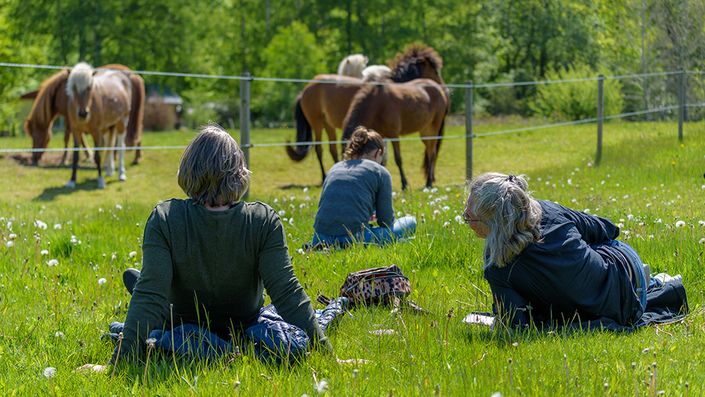
The role of Motion, Emotion, Communication, and our shared Neurobiology
In EATIC Level 1:2 we dive deeper into the mental/cognitive capacities of equines (foremost horses), the equine's perceptions and into the neurobiology of the equine central nervous system. We will also draw parallels between this knowledge and what we know about equine behaviors, in domestic horses and in wild/feral horses. To broaden the understanding of horses we will also study how equines communicate (intentionally or unintentionally), besides trough their overt behaviors. We will be doing comparisons with humans (and sometimes dogs and other animals) to see where we are similar, as being mammalian species, but also where we differ.
We will anchor these discussions in theories about Motion, Emotion, Communication and Neurobiology - and learn about both the horse and the human side of how the theories can help you think around your work, but also how you can put these theories into practice.
We continue to emphasize your own skills as observers of equine behaviors, and other means a horse uses to communicate. So there will again be practical work out in the fields, observing and interacting with equines, to connect what you learn, what we discuss, with what you do. As well as practices to how to incorporate what you learn into EATIC sessions.
Two Species
Level 1:2 builds on the observations and begins incorporating more observation and structured/semi-structured horse-human interactions so that participants view multiple interactions of each dyad and practice recording. Participants practice looking for patterns for two reasons;
- Relaying observations back to the treatment team to assist in reaching the proposed goals for the client.
- Looking at the horse behavior with a critical eye towards perspective and welfare.
The interaction and language that develops is a key factor in determining the effectiveness of the treatment and if it is in line with the goals. Knowing equine behavior and equine-human interactions is a critical component of looking at the interaction and knowing if it fits with therapeutic goals. We will discuss:
- Overlaps and differences in human and horse ethology and how it applies to different EAP/EAL programs and models and practices/activities – specifically addressing the environment at the venue where the training is taking place and the effects of different facilities on horses and horse-human interactions.
- EATIC approaches to incorporating behavioral and emotional regulation (grounding/mindfulness).
- Incorporating nature and the importance of nature/outdoors. Compare with indoor venues. Discuss options for working with horses and catering to the venue.
- Emphasize the importance of knowing each horse individually. Each and horse and a human create a unique dyad and therefore a unique language that develops between them. The overlap in ethology and practical approach to using comparative physiology and comparative psychology to assist in the therapeutic process.
We will continue to apply observational skills learned in level 1:1.
- Observe individual interactions and activities with horses over the course of the training.
- Parallel these observations with client goals related to trauma, anxiety, and depression (additional diagnoses or criteria will be addressed if requested for the location and attendees).

Emotion
Emotions are active regulators of behavior, movement, and intention and mediate social interactions. We will look at the role of emotions for both horse and human in the context of EATIC, based on client goals.

Motion
We will look closer at different aspects of movement, in horses, between horses and between humans and horses.

Communication
Equine behavior is communication. We will look at how horses communicate with each other and us humans and how the communication evolves.
Physiology and neurobiology – and structure of sessions
We will introduce how to structure an EATIC session so it aligns with equine and human ethology, promoting welfare for both horse and human, and aligning activities with outcomes that promote welfare for all. (In-depth flow charts are developed in EATIC Level 3.)

Example Curriculum
- Welcome to EATIC 1:2 & Instructions!
- EATIC Level 1:2 Required Readings and Level 1:2 Manual
- Recommended Readings
- VIDEO: Disclaimer & Links to Resources (1:07)
- DISCUSSION BOARD: Introductions
- LIVE SESSIONS
- MAIN DISCUSSION BOARD: Questions for the Course Leaders
- VIDEO: How we Work (18:03)
- VIDEO 1: Introduction and Orientation (3:19)
- Introduction QUIZ
- Preparation for Practical Work
- Mandatory Practical Component
- PRACTICAL EXERCIE 1: Horse Observations - Affiliative and Agonistic Behaviors
- PRACTICAL EXERCIE 2: Attachment and Relationships
- PRACTICAL EXERCIE 3: Emotions and Motion
- PRACTICAL EXERCIE 4: Intersubjectivity, Connection and Trauma
- EXAM: Final Presentation/Evaluation
- FEEDBACK: To the Trainers
- CERTIFICATE OF COMPLETION: EATIC Level 1:2


